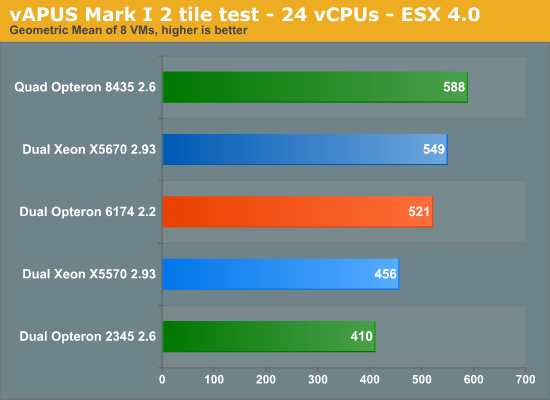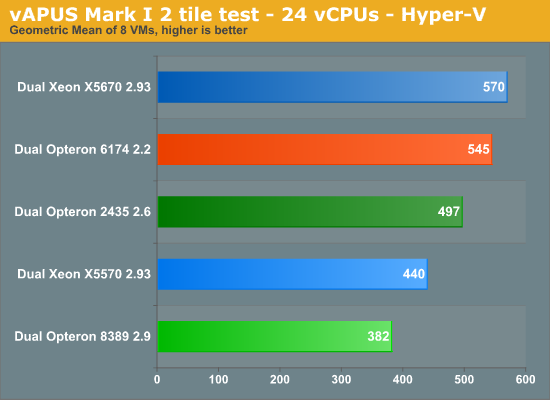AMD's 12-core "Magny-Cours" Opteron 6174 vs. Intel's 6-core Xeon
by Johan De Gelas on March 29, 2010 12:00 AM EST- Posted in
- IT Computing
vApus Mark I: Performance-Critical Applications Virtualized
Our vApus Mark I benchmark is not a VMmark replacement. It is meant to be complimentary: while VMmark uses runs 60 to 120 light loads, vApus Mark I runs 8 heavy VMs on 24 virtual CPUs (vCPUs). Our current vApus Stressclient is being improved to scale to much higher amount of vCPUs, but currently we limit the benchmark to 24 virtual CPUs.
A vApus Mark I tile consists of one OLTP, one OLAP and two heavy websites are combined in one tile. These are the kind of demanding applications that still got their own dedicated and natively running machine a year ago. vApus Mark I shows what will happen if you virtualize them. If you want to fully understand our benchmark methodology: vApus Mark I has been described in great detail here. We have changed only one thing compared to our original benchmarking: we used large pages as it is generally considered as a best practice (with RVI, EPT).
The current vApus Mark I uses two tiles. Per tile we have 4 VMs with 4 server applications:
- A SQL Server 2008 x64 database running on Windows 2008 64-bit, stress tested by our in-house developed vApus test (4 vCPUs).
- Two heavy duty MCS eFMS portals running PHP, IIS on Windows 2003 R2, stress tested by our in house developed vApus test (each 2 vCPUs).
- One OLTP database, based on Oracle 10G Calling Circle benchmark of Dominic Giles (4 vCPUs).
The beauty is that vApus (stress testing software developed by the Sizing Servers Lab) uses actions made by real people (as can be seen in logs) to stress test the VMs, not some benchmarking algorithm.
Update: We have noticed that the CPU load of Magny-cours is at 70-85%, while the Six-core "Istanbul" is running at 80-95%". As we have noted before, 24 cores is at the limit of our current benchmark until we launch vApus Mark 2. We have reason to believe that the opteron 6174 has quite a bit of headroom left. The results above are not wrong, but do not show the full potential of the 6174. We are checking the CPU load numbers of the six-core Xeon X5670 as we speak. Expect an update in the coming days.

The AMD Opteron 6174 performs well here, but disappoints a bit at the same time. vApus Mark I does not scale as well as VMmark. The reason is simple: as we used 4 virtual CPUs for both the OLTP as the OLAP virtual machine, scaling depends more on the individual applications. One VM with 4 virtual CPUs will not scale as well as 16 VMs sharing the same 4 virtual CPUs. Also, we use heavy database applications that typically like a decent amount of cache. The difference with the Xeon X5670 is small though. Servers based on both CPUs will make excellent virtualization platforms.
Next, the same test with Hyper-V, the hypervisor beneath Windows 2008 R2. We are testing with Hyper-V R2 6.1.7600.16385 (21st of July 2009).

Based on the excellent results of the Dual Opteron 2435 we expected AMD to take the crown in this benchmark, but that did not happen. We only had one week to get all of the Opteron testing done (AMD didn't have any hardware until the last minute), so we could not analyze this in depth. For some reason, the Opteron 6174 does not scale very well in our vApus benchmark. Compared to a 2.2GHz six-core, we only see a 30% increase in performance, about the same as Intel gets out of adding 2 extra cores to their Xeon. Part of the reason might be our benchmark: at the moment we are limited to 24 CPUs. We’ll investigate this in more detail in the coming quarter when vApus v2 is available.
The difference with the Xeon X5670 is small though, and the slightly lower price of the Opteron makes up for the slightly lower performance.










58 Comments
View All Comments
Accord99 - Monday, March 29, 2010 - link
The X5670 is 6-core.JackPack - Tuesday, March 30, 2010 - link
LOL. Based on price?Sorry, but you do realize that the majority of these 6-core SKUs will be sold to customers where the CPU represents a small fraction of the system cost?
We're talking $40,000 to $60,000 for a chassis and four fully loaded blades. A couple hundred dollars difference for the processor means nothing. What's important is the performance and the RAS features.
JohanAnandtech - Tuesday, March 30, 2010 - link
Good post. Indeed, many enthusiast don't fully understand how it works in the IT world. Some parts of the market are very price sensitive and will look at a few hundreds of dollars more (like HPC, rendering, webhosting), as the price per server is low. A large part of the market won't care at all. If you are paying $30K for a software license, you are not going to notice a few hundred dollars on the CPUs.Sahrin - Tuesday, March 30, 2010 - link
If that's true, then why did you benchmark the slower parts at all? If it only matters in HPC, then why test it in database? Why would the IDM's spend time and money binning CPU's?Responding with "Product differentiation and IDM/OEM price spreads" simply means that it *does* matter from a price perspetive.
rbbot - Saturday, July 10, 2010 - link
Because those of us with applications running on older machines need comparisons against older systems in order to determine whether it is worth migrating existing applications to a new platform. Personally, I'd like to see more comparisons to even older kit in the 2-3 year range that more people will be upgrading from.Calin - Monday, March 29, 2010 - link
Some programs were licensed by physical processor chips, others were licensed by logical cores. Is this still correct, and if so, could you explain in based on the software used for benchmarking?AmdInside - Monday, March 29, 2010 - link
Can we get any Photoshop benchmarks?JohanAnandtech - Monday, March 29, 2010 - link
I have to check, but I doubt that besides a very exotic operation anything is going to scale beyond 4-8 cores. These CPUs are not made for Photoshop IMHO.AssBall - Tuesday, March 30, 2010 - link
Not sure why you would be running photoshop on a high end server.Nockeln - Tuesday, March 30, 2010 - link
I would recommend trying to apply some advanced filters on a 200+ GB file.Especially with the new higher megapixel cameras I could easilly see how some proffesionals would fork up the cash if this reduces the time they have to spend in front of the screen waiting on things to process.